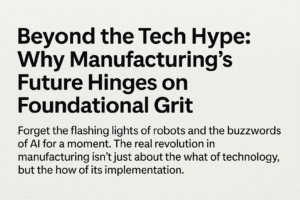Beyond the Tech Hype: Why Manufacturing’s Future Hinges on Foundational Grit
Manufacturing’s future lies not in flashy technologies but in disciplined execution and solid foundations. While Indian manufacturers face immense pressure to adopt AI, IoT, automation, and cloud platforms, many fail to achieve real impact due to broken processes, poor data quality, and unprepared workforces.
True leaders focus on process clarity, leveraging tools like process mining to identify inefficiencies before automating. They build a robust data culture with standardized definitions, real-time access, and actionable insights. People remain at the core, with training, trust, and collaboration driving successful transformation. AI and digital twins become powerful enablers only when grounded in reliable processes and data. Companies must pause to ask if their workflows are efficient, data is trustworthy, and teams are ready.
Those who prioritize foundational grit—process discipline, data integrity, and workforce development—will create scalable, intelligent, and resilient operations. The future of manufacturing growth is defined not by trends but by mastering the basics.

Beyond the Tech Hype: Why Manufacturing’s Future Hinges on Foundational Grit
Forget the flashing lights of robots and the buzzwords of AI for a moment. The real revolution in manufacturing isn’t just about the what of technology, but the how of its implementation. As one industry leader recently argued, echoing the spirit of Toyota’s legendary ‘kaizen’, the path to genuine growth isn’t paved solely with shiny new gadgets, but with disciplined execution and getting the fundamentals right.
The Allure and the Abyss of Digital Promise
Indian manufacturing is undoubtedly at a pivotal moment. Fueled by ambitious government initiatives and facing global disruption, the pressure to rapidly adopt AI, IoT, automation, and cloud platforms is immense. The potential rewards are tantalizing – significant productivity gains predicted by a vast majority of manufacturers. Yet, a sobering reality persists: the chasm between technological promise and tangible impact remains wide.
Why? Because too often, technology becomes the goal, not the tool. Pilots proliferate, sensors are slapped onto machines, and AI models are built, but scaling beyond the initial showcase proves elusive. The culprits are rarely the technologies themselves:
- Process Obscurity: Automating a broken process just makes things go wrong faster. If the underlying workflow is inefficient, ambiguous, or poorly understood, technology merely amplifies the chaos.
- Data Silos & Squalor: AI and analytics are only as good as the data they consume. Inconsistent data (manual here, digital there), poor quality, and disconnected systems render even the most sophisticated tools unreliable or useless.
- The Human Element Gap: Employees untrained, untrusted, or unprepared for change become resistors, not enablers. Skimping on structured change management and workforce development is a recipe for stalled adoption.
The Unsexy Secret: Mastering the Groundwork
The manufacturers truly poised to lead aren’t necessarily those with the latest tech. They are the ones investing relentlessly in the unglamorous groundwork:
- Process Clarity is King: Before automating, standardize. Before predicting, understand. Techniques like process mining are proving invaluable. By mapping real-time system data, manufacturers can objectively see where bottlenecks hide, where approvals stall, and where costly manual workarounds undermine efficiency. As highlighted by global examples like Xpress Boats, this clarity can lead to dramatic cost reductions and speed improvements – but only if the underlying data is accurate and integrated.
- Building the Data Foundation: This isn’t just about collection; it’s about creating a data-first culture. This means:
- Shared Definitions: Ensuring everyone speaks the same data language.
- Real-Time Access: Empowering teams with timely information, not just retrospective reports.
- Actionable Insights: Moving beyond dashboards to embed analytics directly into daily decision-making for pricing, demand sensing, and operational adjustments.
- People at the Core: Technology is implemented by and for people. Successful transformations involve teams early, provide robust training, build trust in new tools, and foster a culture of continuous improvement where technology augments human capability, not just replaces it.
AI: The Powerful Enabler, Not the Strategy
When the groundwork is solid – clear processes, clean and connected data, and a prepared workforce – then technologies like AI reveal their true power. They become potent enablers:
- Predicting machine failures with uncanny accuracy (predictive maintenance).
- Optimizing quality control far beyond human consistency.
- Simulating scenarios with digital twins for unprecedented visibility.
- Enabling faster, more informed responses to supply chain shocks.
Without that foundation, AI is just an expensive science project.
The Critical Pause Before the Next Tech Leap
The imperative for Indian manufacturing is clear: agility is non-negotiable. Technology offers powerful levers. However, the key question before investing isn’t “What’s the latest tech?” but:
- Do we truly understand our workflows? (Are they mapped, standardized, efficient?)
- Is our data trustworthy and unified? (Can we rely on it for critical decisions?)
- Are our people ready, willing, and able? (Do they have the skills and buy-in?)
- Are we solving the right problem? (Or just chasing a tech trend?)
The Takeaway: Leading Growth Requires Foundational Focus
The future of Indian manufacturing growth won’t be won by the company with the most robots or the fanciest AI pilot. It will be won by those who combine technological ambition with relentless executional discipline. Those who prioritize the unsexy, essential groundwork of process clarity, data integrity, and human capital development will be the ones who move beyond isolated tech wins to build truly intelligent, scalable, and resilient operations. They won’t just participate in the manufacturing renaissance; they will define its trajectory. The revolution, it seems, still starts with getting the basics right.
You must be logged in to post a comment.